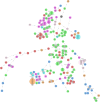Whole-Genome Phylogenetic Analysis Reveals a Wide Diversity of Non-O157 STEC Isolated From Ground Beef and Cattle Feces
- PMID: 33584592
- PMCID: PMC7874142
- DOI: 10.3389/fmicb.2020.622663
Whole-Genome Phylogenetic Analysis Reveals a Wide Diversity of Non-O157 STEC Isolated From Ground Beef and Cattle Feces
Abstract
Shiga toxin-producing Escherichia coli (STEC) causes foodborne outbreaks that can lead to complications such as hemolytic uremic syndrome. Their main reservoir is cattle, and ground beef has been frequently associated with disease and outbreaks. In this study, we attempted to understand the genetic relationship among STEC isolated in Chile from different sources, their relationship to STEC from the rest of the world, and to identify molecular markers of Chilean STEC. We sequenced 62 STEC isolated in Chile using MiSeq Illumina. In silico typing was determined using tools of the Center Genomic Epidemiology, Denmark University (CGE/DTU). Genomes of our local STEC collection were compared with 113 STEC isolated worldwide through a core genome MLST (cgMLST) approach, and we also searched for distinct genes to be used as molecular markers of Chilean isolates. Genomes in our local collection were grouped based on serogroup and sequence type, and clusters were formed within local STEC. In the worldwide STEC analysis, Chilean STEC did not cluster with genomes of the rest of the world suggesting that they are not phylogenetically related to previously described STEC. The pangenome of our STEC collection was 11,650 genes, but we did not identify distinct molecular markers of local STEC. Our results showed that there may be local emerging STEC with unique features, nevertheless, no molecular markers were detected. Therefore, there might be elements such as a syntenic organization that might explain differential clustering detected between local and worldwide STEC.
Keywords: STEC; WGS; diversity; genomics; non-O157 E. coli.
Copyright © 2021 Gutiérrez, Díaz, Reyes-Jara, Yang, Meng, González-Escalona and Toro.
Conflict of interest statement
The authors declare that the research was conducted in the absence of any commercial or financial relationships that could be construed as a potential conflict of interest.
Figures




Similar articles
-
Molecular characterization and phylogeny of Shiga toxin-producing Escherichia coli isolates obtained from two Dutch regions using whole genome sequencing.Clin Microbiol Infect. 2016 Jul;22(7):642.e1-9. doi: 10.1016/j.cmi.2016.03.028. Epub 2016 Apr 4. Clin Microbiol Infect. 2016. PMID: 27058887
-
Genetic Relatedness and Novel Sequence Types of Non-O157 Shiga Toxin-Producing Escherichia coli Strains Isolated in Argentina.Front Cell Infect Microbiol. 2016 Aug 30;6:93. doi: 10.3389/fcimb.2016.00093. eCollection 2016. Front Cell Infect Microbiol. 2016. PMID: 27625995 Free PMC article.
-
High prevalence of non-O157 Shiga toxin-producing Escherichia coli in beef cattle detected by combining four selective agars.BMC Microbiol. 2019 Sep 5;19(1):213. doi: 10.1186/s12866-019-1582-8. BMC Microbiol. 2019. PMID: 31488047 Free PMC article.
-
Prevalence and pathogenicity of Shiga toxin-producing Escherichia coli in beef cattle and their products.J Anim Sci. 2007 Mar;85(13 Suppl):E63-72. doi: 10.2527/jas.2006-421. Epub 2006 Oct 23. J Anim Sci. 2007. PMID: 17060419 Review.
-
Detection, Prevalence, and Pathogenicity of Non-O157 Shiga Toxin-Producing Escherichia coli from Cattle Hides and Carcasses.Foodborne Pathog Dis. 2018 Mar;15(3):119-131. doi: 10.1089/fpd.2017.2401. Foodborne Pathog Dis. 2018. PMID: 29638166 Review.
Cited by
-
Research progress on detection techniques for point-of-care testing of foodborne pathogens.Front Bioeng Biotechnol. 2022 Aug 8;10:958134. doi: 10.3389/fbioe.2022.958134. eCollection 2022. Front Bioeng Biotechnol. 2022. PMID: 36003541 Free PMC article. Review.
-
One day in Denmark: whole-genome sequence-based analysis of Escherichia coli isolates from clinical settings.J Antimicrob Chemother. 2025 Apr 2;80(4):1011-1021. doi: 10.1093/jac/dkaf028. J Antimicrob Chemother. 2025. PMID: 39881516 Free PMC article.
-
Molecular characterization and phylogeny of Shiga toxin-producing Escherichia coli derived from cattle farm.Front Microbiol. 2022 Aug 4;13:950065. doi: 10.3389/fmicb.2022.950065. eCollection 2022. Front Microbiol. 2022. PMID: 35992646 Free PMC article.
-
Genomic Surveillance of Foodborne Pathogens: Advances and Obstacles.J Public Health Manag Pract. 2025 May-Jun 01;31(3):351-359. doi: 10.1097/PHH.0000000000002090. Epub 2024 Nov 14. J Public Health Manag Pract. 2025. PMID: 39757423 Free PMC article.
References
-
- Álvarez-Suárez M.-E., Otero A., García-López M.-L., Dahbi G., Blanco M., Mora A., et al. (2016). Genetic characterization of Shiga toxin-producing Escherichia coli (STEC) and atypical enteropathogenic Escherichia coli (EPEC) isolates from goat’s milk and goat farm environment. Int. J. Food Microbiol. 236 148–154. 10.1016/j.ijfoodmicro.2016.07.035 - DOI - PubMed
-
- Bando S. Y., Iamashita P., Guth B. E., Dos Santos L. F., Fujita A., Abe C. M., et al. (2017). A hemolytic-uremic syndrome-associated strain O113:H21 Shiga toxin-producing Escherichia coli specifically expresses a transcriptional module containing dicA and is related to gene network dysregulation in Caco-2 cells. PLoS One 12:e0189613. 10.1371/journal.pone.0189613 - DOI - PMC - PubMed
-
- Blanco M., Padola N. L., Krüger A., Sanz M. E., Blanco J. E., González E. A., et al. (2004). Virulence genes and intimin types of Shiga-toxin-producing Escherichia coli isolated from cattle and beef products in Argentina. Int. Microbiol. Off. J. Spanish Soc. Microbiol. 7 269–276. - PubMed
LinkOut - more resources
Full Text Sources
Other Literature Sources

